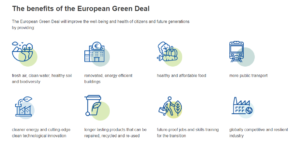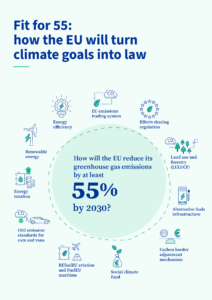The EU Commission has introduced an effective ban on all new carbon-emitting cars by 2035. Confused? Afraid that with your ever-growing student loans you will never be able to afford an
electric car? Should you start saving up for a Tesla? This article will endeavor to answer all your questions and explain what to expect from this revision to the existing Regulation (EU) 2019/631 on standards for carbon emission for passenger cars and light commercial vehicles. (1) As of June 2022, this proposed revision has been adopted by the EU Parliament. (2)
What does the revision do?
The revision sets forth new and more ambitious standards for reducing carbon emissions in the transport sector. This includes that by 2035, car manufacturers must reduce carbon emissions by
100% for new cars, which creates, in effect, a ban on the sale of new petrol and diesel cars. (3) This revision sets a higher bar for the reduction of carbon emissions by both new passenger cars and
vans. This reduction is compared to the carbon emission limits in 2021 (95g CO2/km) by 2030. (4)
| Target by 2030 | Target by 2035 | |
| Original Regulation 2019/631 | 37.5% less CO2 | – |
| Revision introduced | 55% less for passender cars, 50% less for new vans | 100% reduction in carbon emissions for new passenger cars. |
Table 1
A 100% reduction in carbon emissions for new passenger cars essentially amounts to a ban on any new carbon-emitting car by 2035. (5)
Are there any exceptions?
There is, however, a possibility for manufacturers who have less than 1000 new vehicle registrations to apply for a derogation from the emissions targets from 2030. (6) The Commission will issue a “report on the progress towards zero-emission road mobility by 31 December 2025 and every two years thereafter. Based on these reports, the Commission will have to review the effectiveness and impact of the Regulation in 2028.” (7)
Are they going to take our current cars away from us?
No, your car is safe. Any carbon emitting cars bought before 2035 can still be used until the car’s life span runs out. The rules just ban car manufacturers from making new cars that are still carbon
emitting.
Why are they doing this?
This revision is part of the EU’s “Fit for 55” collection of new laws introduced to deliver on a 55% reduction in EU carbon emissions by 2030. This is all to achieve the European Green Deal – the
commitment to a carbon-neutral Europe and doing our part to reduce and limit climate change. (8)
(9) Source: https://commission.europa.eu/strategy-and-policy/priorities-2019-2024/european-green-
deal_en
So… we DO have to buy Teslas?
Our generation will probably end up buying non-carbon emitting cars in our lifetimes, but they don’t have to be Teslas. According to European Green Deal Executive Vice-President Frans Timmermans, “European carmakers are already proving they are ready to step up to the plate, with increasing and increasingly affordable electric cars coming to the market”. (10) The goal of this amendment is to encourage even more competition amongst “manufacturers to invest in research and innovation into electric vehicles, which should drive the purchase price down”. (11) With 2035 being 13 years away, the hope is that announcing this now, will push more car manufacturers into action. Tesla may have been the first one on the market, but they are now in good company. More competition will breed variety and affordability, so there is hope for the Tesla-phobics among us. They also do not need to be electric cars. Hydrogen cars contain an electric motor that is powered by fuel cells with hydrogen – “the most abundant element in the universe (a renewable fuel source).” (12) Still, because electric cars are cheaper and have more advanced infrastructure like refueling stations, the focus seems to be on electric vehicles. This might be mitigated by one of the Fit for 55 plans to build up a more robust alternative fuels infrastructure. (13)
Even with increased competition between car manufacturers, electric cars are still expensive. How will our generation ever be able to afford to drive?
This Is a valid concern. The issue really is acquiring these cars rather than the continued use of them, since the cost of owning and using an electric car will be the same or cheaper than petrol cars (electricity is cheaper than petrol). (14) There is no second-hand market for acquiring electric vehicles yet, and this revision changes the car manufacturing business significantly. These manufacturers could pass on these additional costs to consumers. Implementing this revision and the other new proposals in the Fit-for-55 package is no small feat, and it might cost us.
But there is hope. To address this, the EU has said that it will come with a Social Climate Fund which will help "vulnerable households, micro-businesses and transport users meet the costs of the green energy transition in the buildings and road transport sector. (15) We will have to wait and see how this plan impacts vulnerable consumers and households.
The bigger picture
The EU is committed to the EU Green Deal and that they are working hard towards becoming a leader in the fight against Climate Change. This revision is one of many which all aim to reduce our carbon emissions. This is an overview of all the goals of the Fit for 55 package of laws: (16)
Source: https://www.consilium.europa.eu/en/policies/green-deal/fit-for-55-the-eu-plan-for-a-green-transition/
Ultimately, there is no doubt that we have to make a change. Shifting towards carbon neutral transport, be it electric cars or hydrogen ones, is a step in the right direction. After all, there are no
cars on a dead planet.
1 European Parliament Legislative Train Schedule, “Revision of CO2 emission performance standards for cars and vans, as part of the European Green Deal” (European Parliament, 20 February 2023) https://www.europarl.europa.eu/legislative-train/theme-a-european-green-deal/file-co2-emission-standards-for-cars-and-vans-post-euro6vi-emission-standards> accessed 6 March 2023.
2 European Parliament, “EU ban on the sale of new petrol and diesel cars from 2035 explained” (European Parliament News, 13 February
2023)
3 Kate Abnett, “EU approves effective ban on new fossil fuel cars from 2035” (Reuters, 28 October 2022)
4 European Parliament Legislative Train Schedule, “Revision of CO2 emission performance standards for cars and vans, as part of the European Green Deal” (European Parliament, 20 February 2023)
5 Ibid.
6 Ibid.
7 Ibid.
8 European Commission, “A European Green Deal” (European Commission, 14 February 2023) < https://commission.europa.eu/strategy-and-policy/priorities-2019-2024/european-green-deal_en> accessed 6 March 2023.
9 Ibid.
10 Jacqueline Holman, “European Parliament agrees all new vehicles in EU to be zero emission by 2035” (S&P Global Commodity Insights, 28 October 2022)
11 European Parliament, “EU ban on the sale of new petrol and diesel cars from 2035 explained” (European Parliament News, 13 February 2023)
12 TWI, “What are the key differences between hydrogen and electric cars?” < https://www.twi-global.com/technical-knowledge/faqs/hydrogen-vs-electric-cars#HowHydrogenandElectricCarsWork> accessed 6 March 2023.
13 Council of the European Union, “Fit for 55: Council adopts its position on three texts relating to the transport sector” (Council of the EU, 2 June 2022) < https://www.consilium.europa.eu/en/press/press-releases/2022/06/02/fit-for-55-package-council-adopts-its-position-on-three-texts-relating-to-the-transport-sector/> accessed 6 March 2023.
14 European Parliament, “EU ban on the sale of new petrol and diesel cars from 2035 explained” (European Parliament News, 13 February 2023)
15 Think Tank European Parliament, “Social climate fund: Fit for 55” (Think Tank European Parliament, 15 June 2022) https://www.europarl.europa.eu/thinktank/en/document/EPRS_BRI(2021)698777 accessed 6 March 2023.
16 Council of the European Union, “Fit for 55” (Council of the European Union, 12 January 2023) < https://www.consilium.europa.eu/en/policies/green-deal/fit-for-55-the-eu-plan-for-a-green-transition/> accessed 6 March 2023.
17 Council of the European Union, “Fit for 55” (Council of the European Union, 12 January 2023) < https://www.consilium.europa.eu/en/policies/green-deal/fit-for-55-the-eu-plan-for-a-green-transition/> accessed 6 March 2023.










